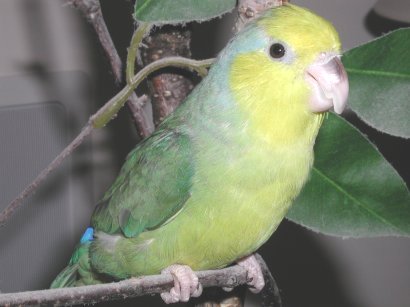Parrotlet - Yellow Faced
Scientific Name: Forpus xanthops
Thu, 9th January, 2025 - 1:46 am GMT
Sponsor Ads:

Alternative Name
Scientific Name: Forpus xanthopsBasic Info
Yellow-faced Parrotlets are predominantly green and are very large, growing to around five and a half inches in length! They are predominantly green and have violet-blue streaks behind their eyes as well as cobalt blue rumps, backs and wings. While the underparts are mostly greenish-yellow, the underside of the wings is blue and the entire tail is green. Females have lighter blue rumps and the majority of the wings are green. Both sexes have brown irises and legs, and the bills are mostly horn colored with a gray base to the lower mandible. The crown, cheeks and throats of Yellow-faced Parrotlets are all a striking shade of yellow.
Health
Yellow-faced Parrotlets will become sick if fed a vitamin supplement in addition to a pellet diet. They do, however, need a regular vitamin C supplement or high vitamin C food. It is recommended they eat pellets rather than seeds to avoid obesity. Yellow-faced Parrotlets are very susceptible to cold-related disorders or infectious diseases. Many die without any known cause; it is thought that the deaths may be stress-related. They do best when kept in a nine by three by six foot aviary. Breeding Yellow-faced Parrotlets who are breeding should be fed a calcium supplement. They may be relatively difficult to breed in captivity, but will usually breed year round. The majority of the matings take place in April and May; a blackish tint on the bill signifies that the birds are ready to breed! Provide a budgerigar sized nesting box in the aviary, and Yellow-faced Parrotlets will produce a clutch of four to six eggs! These will incubate for about 22 days but not all will hatch. The fledgling period lasts four to five weeks, and after the young are independent it is important to remove them from the aviary lest the parents become aggressive toward them when they start breeding again. Baby Yellow-faced Parrotlets can be hand-fed on insect softfood. Although they reach sexual maturity around ten months, they usually do not breed until they are about two years of age.Habitat
N/ABehavior
Yellow-faced Parrotlets have very particular habitation tastes; in the whole world, they live wild in only one valley! They are being bred in captivity so the danger of their disappearance is not too dire. Yellow-faced Parrotlets are sweet, playful little birds. They are very shy, and can die from stress. They acclimatize very slow, and need lots of time to get used to you. Once a Yellow-faced Parrotlet feels comfortable with you, he will be quite confiding. They should be kept alone or they can develop jealousy or aggression problems concerning everything from toys to owners- parrotlets in general do not like sharing what they consider their possessions! Yellow-faced Parrotlets seem to like to play with their food more than they like to eat it, and can be quite wasteful! Be careful when taking your parrotlet outside; even Yellow-faced Parrotlets with clipped wings may be able to fly! Yellow-faced Parrotlets need lots of toys, and adore swings and rope or anything they can chew on! They are quite strong, so be sure the toys will stand up to their hard beaks. Parrotlets bond strongly with the person who spends the most time with them, especially during the time when they are between six and 12 weeks old. Try to keep your Yellow-faced Parrotlet in a cage that is much higher than it is wide, and provide him with plenty of perches. These birds also love to chew on upright willow twigs. They need a nesting box or shrubbery to hide in while in an aviary. It is recommended that Yellow-faced Parrotlets be kept in large cages or aviaries, because in a small cage they can become obese. If you must cage your Yellow-faced Parrotlet, be sure the cage is no smaller than 48 by 16 by 20 inches in dimension.Origin
PeruHistory
Yellow-faced Parrotlets are not uncommon in Europe. In the United States, there are only about ten breeding pairs. They all descend from one bird imported in 1980. Yellow-faced Parrotlets are losing their habitat, and as they become more and more scarce in the wild, captive breeding of these lovely birds becomes more and more important.Common Foods
Yellow-faced Parrotlets should be fed a pellet diet or a basic seed mix, supplemented with plenty of fresh fruits, greenfood, vegetables and of course, they need fresh water at all times. If your Parrotlet is eating seeds rather than pellets, supplement tSponsor Ads:
Bad men live that they may eat and drink, whereas good men eat and drink that they may live. -- Socrates
Parrotlet - Yellow Faced
Coded by: BGID® | ALL RIGHTS RESERVED Copyright © 2000-2025
Disclaimer | Privacy | Report Errors / Contact | Credits


 Preparing For China. China is growing their military. China Military Technology - can it keep up with the US?
Preparing For China. China is growing their military. China Military Technology - can it keep up with the US?  versus
versus 

 versus
versus 
 This Thread is about the North Korean Military itself - the kind of army, navy, and air force they have.
This Thread is about the North Korean Military itself - the kind of army, navy, and air force they have. 
 versus
versus 
 versus
versus  versus
versus